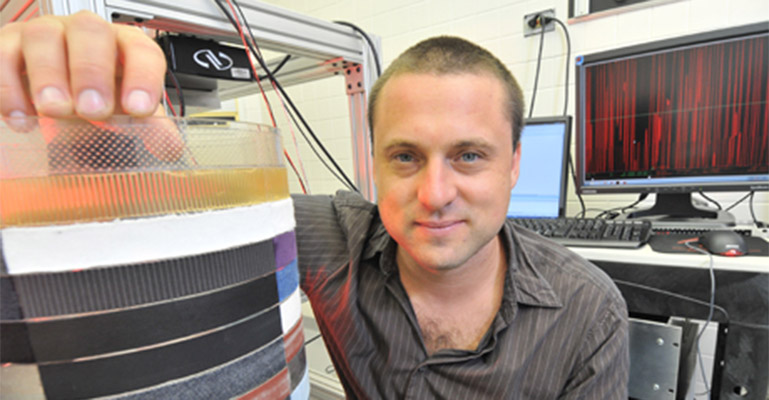The Faculty

Sliman Bensmaia
Associate Professor, Department of Organismal Biology and Anatomy
Affiliation: Organismal Biology & Anatomy
Emailsliman@uchicago.edu
Websitehttp://bensmaialab.org
Focus
Neural coding and the neural basis of perception
Biography
1996-2003 Research Assistant, Department of Psychology, University of North Carolina.
2003-2006 Postdoctoral Fellow, Krieger Mind/Brain Institute, Johns Hopkins University.
2006-2009 Associate Research Scientist, Krieger Mind/Brain Institute, Johns Hopkins University.
2009-Assistant Professor, Department of Organismal Biology and Anatomy, University of Chicago.
Honors
2002 Baughman Dissertation Research Award for innovative dissertation projects
Research Interests
Tactile sensation is critical for effective object manipulation, but current prosthetic upper limbs make no provision for delivering haptic feedback to the user. For individuals who require use of prosthetic limbs, this lack of feedback transforms a mundane task into one that requires herculean concentration and effort. Although vibrotactile motors and sensory substitution devices can be used to convey gross sensations, a direct neural interface is required to provide detailed and intuitive sensory feedback. In view of this, the new generation of neuroprostheses will enable electrical stimulation of somatosensory neurons in the peripheral nervous system. My research background makes me uniquely qualified to address this problem. First, I have published a number of papers in which I characterize how a variety of sensory dimensions are encoded in the responses of neurons in primary somatosensory cortex of primates. Specifically, I have investigated how neurons in the brain encode the shape of an object grasped in the hand and its motion across the skin. I am currently working on how surface texture is represented in the brain. Second, I have published a number of studies in which I characterize the response properties of mechanoreceptive afferents and describe quantitatively how information about various sensory dimensions is conveyed in the responses of populations of afferents. For instance, I have revealed the peripheral neural code for contact force, of critical importance to understanding how this dimension is represented in the brain. Third, I have developed, over the last decade, the state-of-the-art in models of mechanotransduction, with which I can predict with millisecond accuracy the responses of mechanoreceptive afferents to arbitrarily complex spatio-temporal stimuli impinging upon the skin, models that far surpass any other available models, both in the accuracy of their predictions and in their versatility; I have also shown how these models can be used to convey verisimilar percepts through electrical stimulation of the peripheral nerve. Again, understanding how sensory information is represented in the nerve will inform how it is represented in the brain, and ultimately, how to mimic the native neural representations. Fourth, I have been involved with Revolutionizing Prosthetics (Phases 2 and 3), a research program run out of the Johns Hopkins Applied Physics laboratory and funded by the Defense Advanced Research Projects Agency, for which I have been investigating methods to convey sensory information through microstimulation of the somatosensory cortex. The behavioral assays used in my cortical microstimulation studies can readily be applied to test approaches to conveying feedback across a variety of conditions.
Selected publications
-
Bensmaia, S.J., Tyler, D.J., & Micera, S. (2020). Restoration of sensory information via bionic hands, Nature Biomedical Engineering, 1-13.
Ortiz-Catalan, M., Mastinu, E., Greenspon, C.M., Bensmaia, S.J. (in press). Chronic use of a sensitized bionic hand does not remap the sense of touch, Cell Reports
Suresh, A.K., Goodman, J.M., Okorokova, E.V., Kaufman, M.T., Hatsopoulos, N.G., Bensmaia, S.J. (in press). Neural Population Dynamics in Motor Cortex are Different for Reach and Grasp, eLife.
Yan, Y., Goodman, J.M., Moore, D.D. Solla, S.A., & Bensmaia, S.J. (2020). Unexpected complexity of everyday manual behaviors, Nature Communications, 11, 3564. (PubMed)
Callier, T., Brantly, N., Caravelli, A., & Bensmaia, S.J. (2020). The frequency of cortical microstimulation shapes artificial touch, Proceedings of the National Academy of Sciences, 117, 1191-1200. (PubMed)
Goodman, J.M., Tabot, G.A., Lee, A.S., Suresh, A.K., Rajan, A.T., Hatsopoulos, N.G., & Bensmaia, S.J. (2019). Postural representations of the hand in primate sensorimotor cortex, Neuron (PubMed)
George, J.A., Kluger, D.T., Davis, T.S., Wendelden, S.M., Okorokova, E.V., He, Q., Duncan, C.C., Hutchinson, D.T., Thumser Z.C., Beckler, D.T., Marasco, P.D., Bensmaia, S.J., & Clark, G.A. (2019). Biomimetic sensory feedback through peripheral nerve stimulation improves dexterous use of a bionic hand, Science Robotics, 4: eaax2352. (Science Robotics)
Delhaye, B.P., O’Donnell, M.K., Lieber, J.D., McLellan, K.R., & Bensmaia, S.J. (2019). Feeling fooled: texture contaminates the neural code for tactile speed, Public Library of Science Biology, 17: e3000431 (PubMed)
Lieber, J.D. & Bensmaia, S.J. (2019). High dimensional representation of texture in the somatosensory cortex of primates, Proceedings of the National Academy of Sciences, 116: 3268-3277 (PubMed)
Saal, H.P., Delhaye, B.P., Rayhaun, B.C., & Bensmaia, S.J. (2017). Simulating tactile signals from the whole hand with millisecond precision, Proceedings of the National Academy of Sciences, 114: E5693-E5702 (PubMed)
Makin, T.R. & Bensmaia, S.J. (2017). Stability of sensory topographies in adult somatosensory cortex, Trends in Cognitive Sciences, 21, 195-204. (PubMed)
Flesher, S.N., Collinger, J.L., Foldes, S.T., Weiss, J.M., Downey, J.E., Tyler-Kabara, E.C., Bensmaia, S.J., Schwartz, A.B., Boninger, M.L., & Gaunt, R.A. (2016). Intracortical microstimulation of human somatosensory cortex, Science Translational Medicine, 8: 361ra141 (PubMed)
Graczyk, E.L., Schiefer, M.A., Saal, H.P., Delhaye, B.P., Bensmaia, S.J., & Tyler, D.J. (2016). The neural basis of perceived intensity in natural and artificial touch, Science Translational Medicine, 8: 362ra142 (PubMed)



